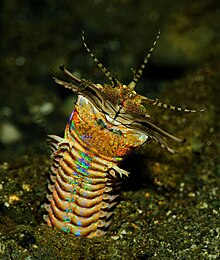Eunicida
| Eunicida Temporal range:
| |
|---|---|

| |
| Eunice aphroditois | |
| Scientific classification | |
| Domain: | Eukaryota |
| Kingdom: | Animalia |
| Phylum: | Annelida |
| Clade: | Pleistoannelida |
| Subclass: | Errantia |
| Order: | Eunicida [1] |
| Families | |
Eunicida is an order of polychaete worms.
Characteristics
[edit]Members of this order have an elongated, segmented body and a distinct head, normally with a separate peristomium and prostomium. Many, but not all, live in tubes which vary from a mucous sheath to a tough, horny casing. The palps vary from globular to cylindrical and there are from 0 to 7 antennae, usually smooth but occasionally jointed. There is a muscular pharynx with a dorsal pair of mandibles and a set of ventral, toothed, maxillary plates. Some species have tentacular cirri and all have unbranched parapodia. In some species, dorsal cirri, branchiae, ventral cirri and chaetae occur, but not in others.[2]
Fossil record
[edit]The Devonian Websteroprion is the largest known fossil eunicidan annelid, with estimated length 1–2 m (3 ft 3 in – 6 ft 7 in).[3] It also had the biggest scolecodonts of any prehistoric polychaete, up to 13.2 mm (0.52 in) in length and possibly larger.[3]
Families
[edit]The World Register of Marine Species (WoRMS) includes the following families in the order:[1]
- Amphinomidae
- Dorvilleidae
- Eunicidae
- Hartmaniellidae
- Ichthyotomidae
- Lumbrineridae
- Oenonidae
- Onuphidae
References
[edit]- ^ a b Read, Geoff (2010). Read G, Fauchald K (eds.). "Eunicida". World Polychaeta database. World Register of Marine Species. Retrieved 2012-01-17.
- ^ Eunicida Natural History Museum. Retrieved 2012-01-17.
- ^ a b Eriksson, Mats E.; Parry, Luke A.; Rudkin, David M. (February 2017). "Earth's oldest 'Bobbit worm' – gigantism in a Devonian eunicidan polychaete". Scientific Reports. 7 (2): 239–260. doi:10.1038/srep43061. PMC 5318920. PMID 28220886.
 Data related to Eunicida at Wikispecies
Data related to Eunicida at Wikispecies
